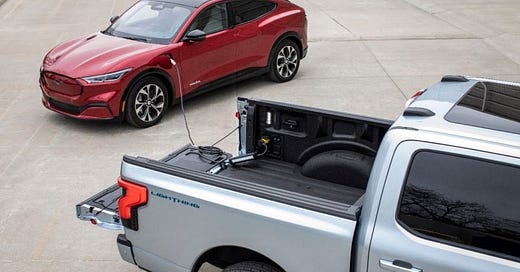Reilly Brennan (RPB) is a transportation investor at Trucks Venture Capital and author of the widely-followed Future of Transportation newsletter. Past contributions to WITI include the Postal Truck Edition and the Walking Meeting Edition.
Reilly here. Electric vehicles are starting to arrive with “bidirectional” or two-way batteries. Instead of just putting power into an EV and draining it, you could transfer it to a different device like a house, or another vehicle.
Ford's new F-150 Lightning electric pickup truck and Volkswagen's ID.4 are examples arriving with this feature, but soon these kinds of vehicles will be everywhere. It follows that buying something like today's “one-directional” batteries might eventually feel a bit limiting. By the end of this decade, doing so will be antiquated.
Why is this interesting?
Making car batteries bidirectional makes them more useful. Huge packs store so much energy that the best use for all those saved electrons might not be a road trip you'll take next Tuesday. They could be used for something more immediate like helping a stranded car, or the clever saving of power you charged cheaply during the nighttime and redirected elsewhere when utility rates climbed. The off-the-grid version of this would be to capture energy through solar cells, stuff it into your pickup truck's battery, then discharge it into your house when you need it.
Doing this isn't easy. It requires designing the battery packs and software differently. And not all charging protocols know how to handle accepting power back into the grid. Researchers have found continual bidirectional use of a battery wears it down faster than normal, too.
But it's more convenient for each consumer. It also might be the thing that starts to untether EVs from the metaphors of the past. Consumers who don't buy EVs today cite a lack of charging infrastructure as one of the biggest hurdles. Gas stations are just more common—roughly 3x more so than charging stations.
But if every one of the estimated 1,000,000 EVs on US roads today were bidirectional, it would represent a charging network seven times larger than our nation's filling stations. Even if you accounted only for Ford's planned F-150 Lightning production targets, there would be more bidirectional Ford “distributed power stations” by the end of one year than all the gas stations in America. While these wouldn’t be charging stations in the sense that you’re going to sit there and fill up your batteries, they would represent a totally new way to think about how we power automobiles. We’d move from planned, large gulps of “fuel” to the freedom of ubiquitous power-sipping if we need it. ‘Range anxiety’ for an individual car might persist, but the nearest charging station might be your neighbor's truck.
The network and economic implications of this are unclear. Will automakers design their vehicles so they can charge only other cars of the same make, and will this boost brand loyalty within multi-car households? Or will they do as Ford has done, in allowing an F-150 Lightning to charge any vehicle regardless of brand? Will charging other vehicles become a revenue source for each car owner? How will owners signal their vehicle has enough power and the willingness to share some with others? I don't know, but the implications for each of these are significant.
120 years ago, cars weren't very useful until they manifested a necessary system around them: roads, gas stations, traffic laws. Bidirectional charging feels like the first real dent in the old system. Just as car design will evolve with EVs, once we move away from fuel destinations and from cars as mere consumers of energy, we begin to rewire the ecosystem. (RPB)
Quick links:
Mercedes EQXX EV concept has a longer range, but not from a bigger battery (RPB)
How I would build the Great Pyramids (RPB)
WITI x McKinsey:
An ongoing partnership where we highlight interesting McKinsey research, writing, and data.
2021: McKinsey Global Publishing’s year in review. What were 2021’s biggest stories? Revisit some of McKinsey’s sharpest insights on the pandemic, the evolving talent crisis, digital and the growth agenda, and sustainability. Explore highlights and gear up to drive sustainable, inclusive growth in 2022 with McKinsey Global Publishing's year in review insights.
Thanks for reading,
Noah (NRB) & Colin (CJN) & Reilly (RPB)
—
Why is this interesting? is a daily email from Noah Brier & Colin Nagy (and friends!) about interesting things. If you’ve enjoyed this edition, please consider forwarding it to a friend. If you’re reading it for the first time, consider subscribing (it’s free!).
Thanks for reading,
Noah (NRB) & Colin (CJN) & Reilly (RPB)
Why is this interesting? is a daily email from Noah Brier & Colin Nagy (and friends!) about interesting things. If you’ve enjoyed this edition, please consider forwarding it to a friend. If you’re reading it for the first time, consider subscribing (it’s free!).






My prediction is that outside of emergency situations, "power sipping" from another EV on the road will be useful the same way as siphoning gas from another vehicle's fuel tank. In other words, not widespread in daylight and not widely accepted socially. Exchanging gunfire at charging lines is more likely.